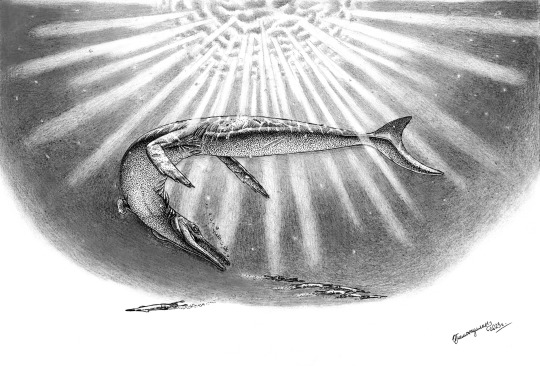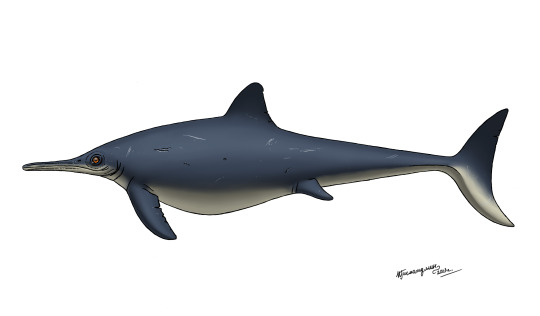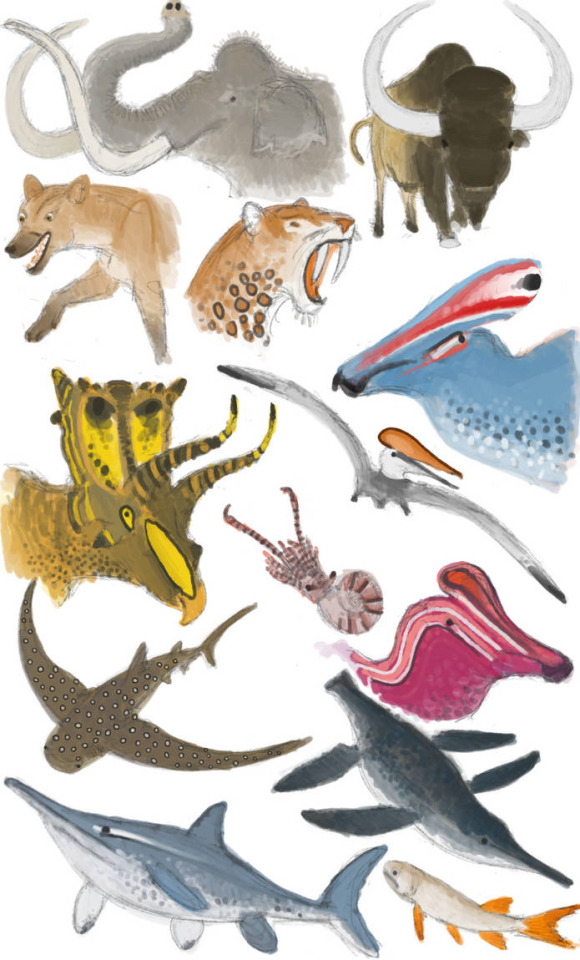#Mauriciosaurus
Explore tagged Tumblr posts
Text
In the spring of last year, I made several color reconstructions of marine reptiles for a thesis and presentation (it was about the reconstruction of marine reptiles) for a conference that was held in Ulyanovsk in September. The drawings were done in ballpoint pen (lineart) and Paint Tool Sai 2.0 (shadows and colors).

The first is reconstruction of Mixosaurus cornalianus, a widespread small Triassic ichthyosaur. I had already drawn a Mixosaurus in water earlier and even wanted to use it in the article, but later changed my mind, deciding that lateral reconstruction would better convey the appearance of soft tissues. This earlier drawing can bee seen here:

Both pieces are based on the fin impressions described in 2020 from a specimen found in the Middle Triassic rocks of the Bezano formation, Italy (www.researchgate.net/publicati…). This specimen has preserved the tissues of the dorsal and caudal fins. Both prints have thin collagen filaments, and at the base of the caudal fin, it was possible to detect the remains of smooth, scaleless skin. The fins have a triangular shape, and the dorsal one is associated with 15-23 trunk vertebrae. In other words, its position turned out to be more
forward then in reconstructions done before his paper.

The second is lateral reconstruction of the metriorhynchid Cricosaurus albersdoerferi, belonging to a widespread genus that inhabited the shallow seas of future Europe, Central America and Argentina. It was not a particularly large animal, reaching from 2 to 3.2 meters in length. Like the first reconstruction of a Cricosaurus, which I performed in the spring, this drawing is based on a specimen that preserved a large volume of soft tissue on the tail (upload.wikimedia.org/wikipedia…). Also shown here is the salt gland in the antorbital fenestra, the presence of which was previously indicated in Cricosaurus araucanensis and Dakosaurus andiniensis. The spring work with C. albersdoerferi can be seen below:


Plesiosaurs are mentioned too. This is reconstruction of the polycotylid Mauriciosaurus fernandezi from the Late Cretaceous of Mexico. A complete reptile skeleton preserved in fine-grained rocks was described by a team of paleontologists in 2017: www.researchgate.net/publicati… There are five types of soft tissue imprints around the bones. Among them are dark material, probably left from the walls of the peritoneum, dark gray traces of blubber and impressions of possible small scales. The impressions show that the animal's belly was covered with rectangular scales, which were mixed with inclusions of small fragments closer to the limbs. The scales of the living reptile were almost indistinguishable, so that the skin looked smooth. This beautifully preserved specimen showed that plesiosaurs had much more soft tissue than previously thought. The tail was especially fleshy. Fat deposits created a smooth, streamlined shape, ideal for an agile swimmer.

The last thesis drawing is this reconstruction of the famous Early Jurassic ichthyosaur Stenopterygius quadriscissus. Many of its skeletons of amazing preservation were found in the fine-grained limestones of Holzmaden, Germany. Some of them were discovered back in the 19th century, which made it possible to quickly correct previous ideas about ichthyosaurs. The Stenopterygius specimens retained soft tissue prints in the form of a bacterial film, which made it clear that they were fish-like creatures with a dorsal fin and a crescent tail. They re still attract the attention of researchers. In 2018, the skin structure of one partial specimen was studied: www.researchgate.net/publicati… A fossilized blubber was described, similar in microstructure to that of marine mammals and leatherback turtles. This led to the conclusion that ichthyosaurs were reptiles with a high metabolism, which required fat insulation. Blubber allowed ichthyosaurs to travel across the oceans, swimming even into the cold polar waters. In addition, this Stenopterygius had pigment cells - melanophores. They were absent on the ventral side, which means that the Stenopterygius had a dark back and a light belly. This countershading coloring is typical of today's marine vertebrates and serves as a camouflage.
I did also three works in fully traditional style, with pens and pencils, but I'll show them in the separate post. :)
#mixosaurus#stenopterygius#ichthyosaurs#cricosaurus#metriorhynchidae#mauriciosaurus#polycotylidae#plesiosaur#mesozoic marine reptiles#paleoart
30 notes
·
View notes
Text

For Cinco de Mayo I've made sketches of some of Mexico's diverse fossil fauna. From bottom to top: Cipactlichthys scutatus, Parrasaurus yacahuitztli, Mauriciosaurus fernandezi, Aquilolamna milarcae, Velafrons coahuilensis, Muzquizopteryx coahuilensis, Orthaspidoceras sp., Coahuilaceratops magnacuerna, Tlatolophus galorum, Amphicyon dirus, Smilodon fatalis, Mammuthus columbi, and Bison latifrons
557 notes
·
View notes
Text
Mauriciosaurus fernandezi

Art by: Nobu Tamura, CC BY-SA 4.0
Name: Mauriciosaurus fernandezi
Name Meaning: Mauricio’s reptile
First Described: 2017
Described By: Frey et al.,
Classification: Chordata, Tetrapoda, Reptilia, Sauropterygia, Plesiosauria, Polycotylidae
Mauriciosaurus was a polycotylid plesiosaur that lived during the Late Cretaceous of what is now known as Mexico. We have a pretty well preserved juvenile specimen that was found in an area with lack of oxygen. The lack of oxygen is actually what helped preserve the soft tissues found within this plesiosaur. Preservation of soft tissues helped paleontologists see evidence of fat or blubber on Mauriciosaurus. So, to all paleoartists out there, please draw your plesiosaurs thicker than ever! This juvenile specimen was estimated to have been 6 feet (1.9 meters) in length.
Sources:
https://en.wikipedia.org/wiki/Mauriciosaurus
#Mauriciosaurus#palaeoblr#paleontology#palaeontology#prehistoric#Mesozoic#ancient marine reptiles#Not a dinosaur#sauropterygia
48 notes
·
View notes
Photo

Mauriciosaurus fernandezi, a polycotylid plesiosaur from the Late Cretaceous of Mexico (~94-89 mya). About 1.9m long (6′3″) with a flipper-span of 1.5m (4′11″), it’s known from a near-complete skeleton with preserved soft tissue impressions. The fossil shows evidence of rows of very tiny scales, the skin outlines of the flippers, and also a thick layer of insulating blubbery fat.
Its body shape in life would have been similar to modern leatherback turtles, roughly teardrop-shaped and hydrodynamic -- much chubbier than most plesiosaur reconstructions had been previously depicting!
#science illustration#paleontology#paleoart#palaeoblr#mauriciosaurus#plesiosaur#polycotylidae#sauropterygia#marine reptiles#pantestudines#stem-turtle#blubber#art#soft tissue preservation#blubbery plesiosaurs confirmed#we need to go fatter#chub-blubs
360 notes
·
View notes
Note
Do you know what's the difference between a mosasaur and a liopleurodon?
sure thing! Plesiosaurs like Liopleurodon and Mosasaurs like Tylosaurus were both gigantic apex predators who got sick of life on land early on and took the ‘LETS GET HUGE AND LUMPY IN THE OCEAN’ route. but aside from that, they really weren’t that similar at all!
to start off, Liopleurodon and the Mosasaurs (pretty good name for a rock band) didn’t even live in the same time period. Liopleurodon lived 166 million years ago during the Jurassic, in the shallow-water seas that once covered Europe. Mosasaurs, on the other hand, only showed up the the ocean party about 70 million years ago, during the late Cretaceous.

and these two animal groups weren’t actually related, apart from both being reptiles. Liopleurodon was a kind of Plesiosaur, an aquatic reptile group related to modern crocodiles that first evolved in the Triassic 203 fucking million years ago and dominated the seas until they got nerfed out of existence by the same event that killed the dinosaurs. during that time, the Plesiosaurs produced apex predators like Liopleurodon, fish-eating wierdos like Elasmosaurus, and even filter feeders like Mortuneria! it was a very diverse group, and lasted a long long time.


BUT the Plesiosaurs as a whole did take a hit during the extinction event that divided the Jurassic from the Cretaceous. this event shook up life on land and finished off the Ichythosaurs, a group of dolphin-like reptiles who had ruled the seas alongside Plesiosaurs until that point. and a lot of Plesiosaurs died out too, including all the apex predators like Liopleurodon. so while Plesiosaurs as a whole kept on truckin into the Cretaceous, it was mostly as smaller, more-lightly built fish-eaters like Mauriciosaurus, who moved into the ecological niche previously occupied by the now-extinct Ichthyosaurs.

so where the hell did Mosasaurs come from? well, evolutionarily speaking, they just came fucking flying out of left field. Mosasaurs were very closely related to our modern Monitor Lizards, and began evolving from their lizardy ancestors basically as soon as things had settled down a bit from the end-Jurassic extinction. by 70 million years ago, this weird lizard group had speedrun its way into the vacant Fuckoff Huge Seamonster slot and evolved into a whole GROUP of gigantic ocean predators that absolutely dwarfed anything that had come before! (for reference, Liopleurodon was 23 feet long. Tylosaurus was over 46 feet long.)

but unfortunately, the Mosasaurs didn’t get a lot of time in the spotlight. they were still cheerfully diversifying as a group up to 66 million years ago, when the Cretaceous–Paleogene extinction event wiped 75% of all species off the face of the planet. including both the Plesiosaurs and the Mosasaurs.

so the next time you go to the ocean, maybe sit on the beach for a bit, stare out at the waves, and think about what it must have been like when these very same waters were patrolled not by whales and dolphins, but by massive reptiles of all shapes and sizes.

it must have been so fucking rad.
2K notes
·
View notes
Note
Can I hear Emile's essay on the Loch Ness Monster? I'm curious
SKAJDLKASJD i'd have to write the essay first (which id actually do if people wanted) the thing emile said is based off what i know about dinosaurs. here's the synopsis. ahem.People attribute the loch ness monster to a late surviving plesiosaurs (Or Sauroperygia) right? That's the most common explanation for nessie's existence. however every 'eye witness', 'photographic evidence' and other 'proof' people have share one thing in common, a curved, swan like neck. plesiosaurs's neck connects at the back of their skull, meaning for them to get that arc they'd have to snap their neck. Furthermore there's been a well preserved mauriciosaurus discovery that suggests that, much like whales and penguins, all sauropergyia would be rather....roundso if nessie existed she'd look like a very very fat whale that didn't bend it's neck thanks for coming to my short ted talk i can actually write an essay if people want i have a lot to say about cryptids
6 notes
·
View notes
Photo
honestly...... anti-shrinkwrapping is ALSO a major problem in paleontology.
The most realistic answer is.... long-necked plesiosaurs PROBABLY DIDN’T look quite nearly that fat. Shorter-necked plesiosasurs, like Mauriciosaurus fernandezi DID look pretty penguin-shaped, though!
As for the sauropod in the original tweet................. no there’s just so much wrong with that

302K notes
·
View notes
Note
No, Plesiosaurs couldn't bend their necks into a vertical swanlike pose. Also, the front flipper/shoulder area might need more muscle. And the tail might need a fin on it. Depends. Some Plesiosaurs show tail fins(Seeleyosaurus had an impression,Cryptoclidus and Muraenosaurus have osteological correlates for a tail fin) but others (Mauriciosaurus) don't. Might have been a matter of phylogeny.
This is very good to know! Plesiosaurs are definitely not my specialty.
21 notes
·
View notes
Text
En Saltillo, presentan al mundo una nueva especie de reptil marino
En Saltillo, presentan al mundo una nueva especie de reptil marino
Se trata del ‘Mauriciosaurus fernandezi’, un plesiosaurio descubierto en 2011 en Vallecillos, NL; fue nombrado así en honor a un exalcalde (more…)
View On WordPress
0 notes
Photo

New Post has been published on http://drubbler.com/2017/03/01/mexican-mayor-named-their-dinosaur-name/
Mexican Mayor named their dinosaur name
(adsbygoogle = window.adsbygoogle || []).push();
Mexico City, March 1, 2017, 6:04- REGNUM a new kind of dinosaur whose fossils were found in the State of Nuevo Leon, was named for the Mayor of a suburb of Monterrey, reports the Associated Press.
Mauricio Fernandez authorized the use of his name for varieties of plesiosaur. Dinosaur, now located in the Museum of the desert in Coahuila, will officially be called Mauriciosaurus fernandezi.
Discovered in the Horseshoe was career employees in the State of Nuevo León in the 2011 year. This type of dinosaur became extinct 66 million years ago.
Journalists note that step policy is brave enough — the word “dinosaur” in Mexico decided to characterize the old corrupt politicians.
Read earlier in the plot: scientists from China discovered protein over 195 million years
If you notice an error in the text, highlight it and press Ctrl + Enter to send information to the editor.
(adsbygoogle = window.adsbygoogle || []).push();
0 notes
Text
Ponen a fósil nombre del alcalde panista de San Pedro
http://conectaabogados.com/ponen-a-fosil-nombre-del-alcalde-panista-de-san-pedro/
Ponen a fósil nombre del alcalde panista de San Pedro
MONTERREY, NL (apro).- El fósil del “Mauriciosaurus fernandezi”, animal descubierto en Nuevo León, fue presentado hoy a la comunidad científica, como un nuevo espécimen que habitó la Tierra hace más de 90 millones de años. El nombre del reptil marino, que mide 1.9 metros de largo, por 1.15 de envergadura de sus aletas, fue nombrado […]
La entrada Ponen a fósil nombre del alcalde panista de San Pedro aparece primero en Proceso.
Nota completa en : Proceso
0 notes
Text
Avala la UNAM el fosil del Alcalde de San Pedro
Avala la UNAM el fosil del Alcalde de San Pedro
Agencia/InsurgentePress, Nuevo León.- Una especie de reptil marino prehistórico llevará el nombre de Mauricio Fernández, Alcalde de San Pedro, Nuevo León, y ya cuenta con aval científico. Se trata del “Mauriciosaurus fernandezi”, cuya investigación publicó el 20 de febrero pasado la Sociedad Geológica Mexicana de la Universidad Nacional Autónoma de México. Esta nueva especie es de la familia de…
View On WordPress
0 notes
Link
Mauriciosaurus, a plesiosaur with extensive soft tissue preservation – revealing that these marine reptiles had a thick layer of insulating fat in life.
#paleontology#palaeoblr#plesiosaur#marine reptiles#mauriciosaurus#polycotylidae#sauropterygia#blubbery plesiosaurs confirmed#chub-blubs#i'm so happy
99 notes
·
View notes